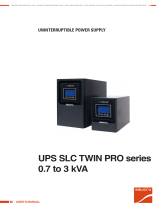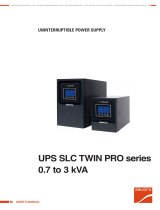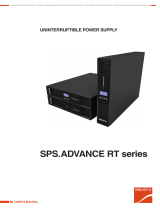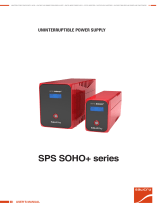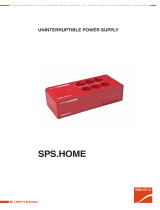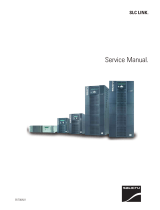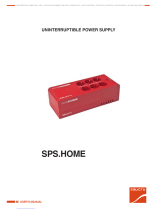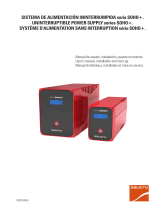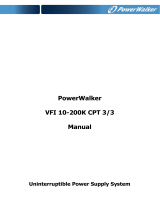
6
• When replacing a fuse, do it for another of the same type, char-
acteristics format and size.
• Under any concept the input power cord will be connected to the
output of the equipment, either directly or through other ways.
• Models with separate bypass line, a galvanic isolation
transformer has to be installed in any of the two lines
that supply the UPS (rectifier input or static bypass), to avoid
the direct union of the neutral of both lines through the in-
ternal wiring of the equipment.
This is applicable when the two lines are supplied from dif-
ferent mains, i.e.:
Two different electrical companies.
An electrical company and genset, ...
• All the equipments have an auxiliary terminal strip to install
an external emergency power off button (EPO), and it will be-
long to the user property.
Type of circuit is selectable through the LCD panel of the
equipment. The contact is preset from factory as normally
open, so the button must be switched to close the circuit and
the voltage to the loads is broken. To establish the power
supply to the loads again, the EPO button must be deacti-
vated.
EPO doesn't affect to the power supply of the equipment, it
only breaks the power supply to the loads as a safety measure.
• When supplying input voltage to a UPS with fitted in or
separate static bypass, although the inverter is still
turned «Off» (deactivated) it doesn't mean that at the output
there will not be voltage.
So, to do it, the input and static bypass switches will have to
be turned «Off».
Put warnings of danger and/or emergency switches if the safety
Standards require it in your particular installation.
• It is possible that the UPS supplies output voltage
through the manual bypass to those equipments that
incorporate it either standard or optional, so it will have to be
considered as regards to safety. If it were necessary to break
the output supply of the equipment in this situation, deactivate
the outgoing distribution protection or in case of lack of it the
general protection of the distribution panel that feeds the UPS.
• All power supply electrical cables have to be fixed to the
equipments and loads, interfaces, etc..., to unmovable parts
and in the way to avoid treads, trips on them or fortuitous
pulls.
• It is essential the Neutral connection to the input in three
phase equipments in the foreseen terminal for that purpose.
• CHASSIS or RACK mounted equipments are destined to be in-
stalled in a predetermined set to be done by professionals.
The installation has to be designed and executed by qual-
ified personnel, who will be the responsible to apply the
safety and EMC regulations and standards that controls
the particular installations where the product is destined.
The equipments assembled in CHASSIS do not have
enclosure protection, even the power blocks are unpro-
tected.
Some RACK mounted equipments do not have the power
blocks protected.
• Never manipulate the equipment with wet hands.
1.2.3.2. To keep in mind.
• Do not try to dismantle or change any part of the
equipment, if this action is not contemplated in this
document. Manipulation inside the UPS due to any modifica-
tion, reparation or any other cause, can make an electrical
discharge of high voltage and it is restricted to qualified staff
only. Do not open the equipment.
A part from the implicit stated risks, any action that make the
modification, internal or external of the equipment or just only
the simple intervention inside of itself, which is not stated in
this document, it can expire the warranty.
• If it is observed that the UPS exhausts smoke or toxic gas,
shutdown it immediately and disconnect it from the power
supply. This kind of fault can cause fire or electrical dis-
charge. Contact with our (S.T.S.).
• In case of an accidental equipment dropping or if the enclo-
sure is damaged, do not start it up under any concept. This
kind of fault can cause fire or electrical discharge. Contact
with our (S.T.S.).
• Do not cut, manipulate the electrical cables, do not put heavy
objects over them too. Any of these actions could cause a
short-circuit and make a fire or electrical discharge.
Check that the electrical cables of connection, plugs and out-
lets are in good conditions.
• When moving an equipment from a cold place to a warm en-
vironment and vice versa, it can cause condensation (small
water drops) in the external and internal surfaces. Before in-
stalling a moved equipment from another place or even pack-
aged, the equipment will be left for a minimum time of two
hours in the new location before making any action, with the
purpose of adapting it to the new environmental conditions
and avoid the possible condensations.
The UPS has to be completely dry before starting any instal-
lation task.
• Do not store, install or expose the equipment in corrosive,
wets, dusty inflammable or explosive environments and
never outdoors.
• Avoid to locate, install or store the equipment in a place with
direct sunlight or high temperatures. Batteries could be dam-
aged.
In the exceptional case and long exposition to intense heat,
batteries can cause filtrations, overheating or explosions,
which can cause fires, burn or other injuries. High tempera-
tures can also make deformation in the plastic enclosure.
• The location will be spacious, airy, away from heat sources
and easy access.
• Do not obstruct the cooling grids by entering objects through
themselves or other orifices.
• In equipments of low power rate (up to 3kVA), leave as min-
imum space of 25 cm in the equipment peripheral and 50 cm
for higher power rates equipments.
• Also in the UPS with power blocks, it is recommended to
leave another additional 50 cm for an eventual intervention
of the (S.T.S.), considering that if it means to move the UPS,
the connected cables will have the needed clearance.
• Do not put materials over the equipment or parts that obstruct
the correct visualization of the synoptic.
• Some equipments can have lifting lugs and together with the
documentation, a screws are supplied to replace them once
the UPS is located, in order to correct the look of the product.
• Be careful to not wet it, because it is not waterproof. Do not
allow entering any kind of liquids in. If accidentally the outside
of the machine comes into contact with liquids or salt air, dry
it with a soft and absorbent cloth.
• To clean the equipment, wipe over a damp cloth and then
dry it. Avoid sprinkling or spillage that could enter through the
slots or cooling grids, which may cause fire or electric shock.
USER MANUAL




















